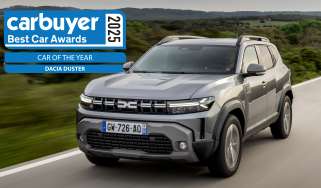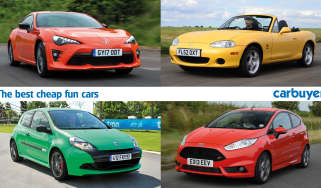Ford Focus review - Engines, drive & performance
The latest Ford Focus jumps straight to the head of the family hatchback pack for handling
Ford is very proud of the 'fun-to-drive' reputation consistently held by the Focus across its four generations. This Mk4 car was the first Ford to use the company's 'C2' platform, which also now underpins the bigger Ford Kuga SUV. It's lighter and stiffer than the previous generation car and Ford also introduced an advanced power-steering system that offers greater feel.
There’s a sophisticated traction-control system that incorporates torque-vectoring control and torque-steer compensation, helping to direct power where it's needed and rein it in where it's not. But does all this technology result in genuine driving pleasure?
The answer is an unreserved yes. Any doubts evaporate when you encounter a twisty road, where the Focus is far more composed than you'd expect a family hatchback to be. Despite being older than both, it still has the edge on the Vauxhall Astra and Volkswagen Golf. The steering lives up to Ford's claims and is among the most communicative power-assisted systems around. There's loads of bite from the front tyres, too – it eagerly locks onto your chosen line around a corner, and there's no drama if you lift off the accelerator sharply.
The Focus rides very well with a suppleness to the suspension that means the bumps are effectively absorbed, but control of the car’s body is retained over larger undulations and around bends. The ST-Line models come with upgraded sports suspension that sits 10mm lower and improve the car’s handling further at the expense of some ride comfort. If you want an even sharper driving experience, you’ll need to go for the full-blown ST hot hatch but the standard Focus should cater for the majority very well.
More reviews
There’s also the Focus Active model that rides 30mm higher and has specific driving modes tailored for low grip surfaces. It’s marginally less composed when cornering than the standard Focus but rides slightly more comfortably.
A six-speed manual gearbox is now only available on the 123bhp version of the 1.0-litre petrol model. It feels slick, if a little weighty in use, and the smooth clutch makes up for the fact that the gearstick moves quite a long way across the gate. If you'd rather have an automatic, you can get Ford’s seven-speed PowerShift auto by opting for the 153bhp version of the 1.0-litre EcoBoost petrol engine. From 2021, the diesel version of the Focus was only available with an eight-speed automatic, but as of mid-2023, the diesel has been discontinued altogether.
The automatic is controlled by a rotary gear selector, which is simple to use, and there are steering-wheel-mounted paddles at hand to enable manual gearchanges. It's generally a smooth gearbox, but prone to the occasional jerky shift. There's also a sense that the gearbox doesn't make full use of the Focus' entire power band by changing up early.
Diesel models
The diesel version of the Focus was discontinued in 2023, but was only ever available with one 1.5-litre, four-cylinder EcoBlue engine. From 2021 it was sold exclusively with an eight-speed automatic gearbox, taking 11.8 seconds to reach 62mph from rest. This engine is a little noisy on start-up – perhaps a little noisier than equivalent diesels in rivals. The clatter dies down quickly, though, and there's a plentiful response when you demand power. There's also barely any difference between the petrol and heavier diesel-engined Focus models when it comes to handling.
| Model | Power | 0-62mph | Top speed |
|---|---|---|---|
| 1.5 Ecoblue diesel 113bhp | 113bhp | 11.8 seconds | 116mph |
Petrol models
We've been impressed by 1.0-litre Ecoboost petrol that’s now common across the Ford model range. The more potent 153bhp version is the one to go for if you can afford it because it betters the 123bhp engine for performance. The Powershift automatic is now the only version of the 153bhp model you can buy, but it was always quicker than the discontinued manual version anyway – quicker shifts help it get from standstill to 62mph in over half a second faster.
All versions of the 1.0-litre make the off-beat thrumming noise that’s common in engines with odd numbers of cylinders but it’s not an unpleasant sound and it’s reduced as the unit warms up. You can tell it's a small engine by its slight hesitation to accelerate under heavy load, but this lethargy evaporates once there's 2,000rpm or more on the rev counter. This does put it slightly off the pace of the equivalent Golf and Astra, though. Both have larger entry-level engines that pull more easily from low revs, with less vibration.
| Model | Power | 0-62mph | Top speed |
|---|---|---|---|
| 1.0 Ecoboost petrol 123bhp mHEV | 123bhp | 10.4 seconds | 124mph |
| 1.0 Ecoboost petrol 153bhp mHEV | 153bhp | 8.6 seconds | 131mph |
| 2.3 Ecoboost petrol 276bhp | 276bhp | 5.8 seconds | 155mph |
Electric and hybrid models
Ford does not currently offer an electric Ford Focus, a plug-in hybrid or a full hybrid. The 1.0-litre Ecoboost petrol engines are available with mild hybrid technology to boost their efficiency but unlike full hybrids these cannot drive any distance on electric power alone. Pure electric cars similar in size to the Focus include the Renault Megane, Nissan Leaf and Volkswagen ID.3.
Carbuyer notes
“There’s no better family hatchback for getting that balance of sharp handling and ride comfort right. And the Focus is strong in most other areas too.”
Andy Goodwin, managing editor.
Which Is Best?
Cheapest
- Name1.0 EcoBoost Hybrid mHEV Titanium 5dr
- Gearbox typeManual
- RRP£28,500
Most Economical
- Name1.0 EcoBoost Hybrid mHEV Titanium 5dr
- Gearbox typeManual
- RRP£28,500
Fastest
- Name2.3 EcoBoost ST 5dr Auto
- Gearbox typeAuto
- RRP£39,155














